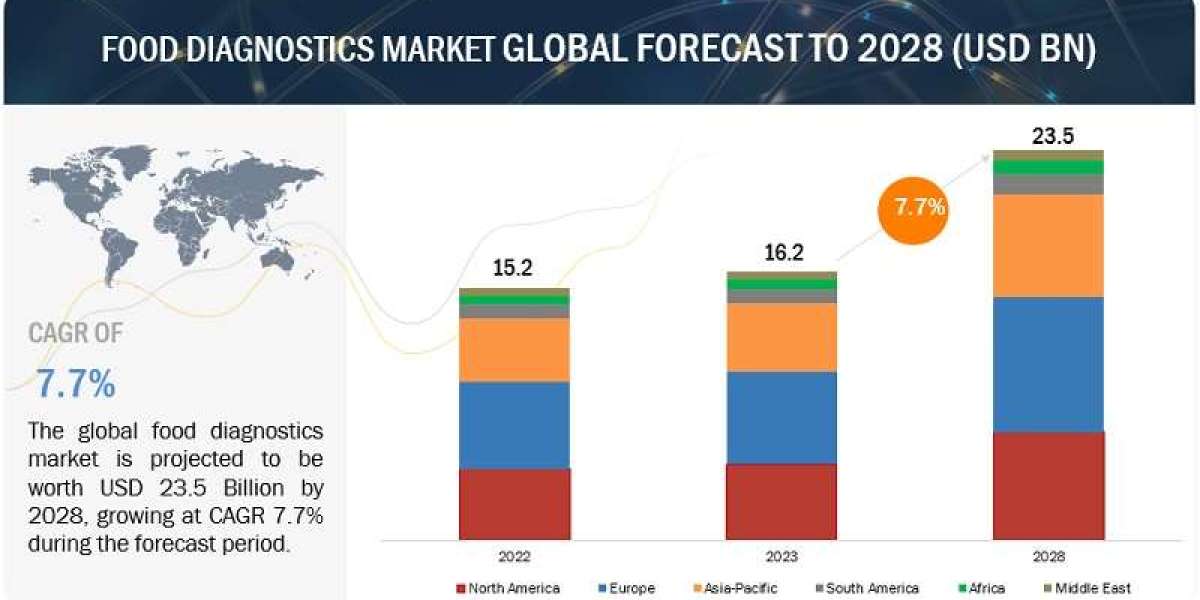The global food diagnostics market is estimated at USD 16.2 billion in 2023 and is projected to reach USD 23.5 billion by 2028, at a CAGR of 7.7% from 2023 to 2028. Food diagnostics involves a range of techniques and technologies used to detect contaminants, pathogens, allergens, and adulterants in food products. The market is primarily driven by the growing concerns regarding food safety, increasing consumer awareness, and stringent regulations imposed by governments worldwide. With the globalization of the food supply chain, the need for accurate and rapid testing methods has surged, fostering innovation in this sector.
Download PDF brochure: https://www.marketsandmarkets.com/pdfdownloadNew.asp?id=225194671
By type, the test kits segment is estimated to grow at the highest CAGR during the forecasted period
Test kits are indispensable tools in the realm of food safety and quality testing. They are designed to provide quick, reliable, and cost-effective results for the presence of contaminants, pathogens, allergens, and quality parameters in various food products. Test kits are user-friendly, allowing even non-specialized personnel to perform tests with minimal training. This accessibility and simplicity make them ideal for on-site testing, where immediate results can lead to prompt corrective actions. Moreover, test kits enable rapid detection, significantly reducing the time required for analysis compared to traditional laboratory methods. This swift response is crucial in preventing contaminated or substandard food products from entering the market, ultimately safeguarding public health.
By food tested, the fruits & vegetables segment is anticipated to grow at a significant rate in the food diagnostics market
The consumption of fruits and vegetables is increasing globally, and consumers are becoming more conscious of the quality and safety of the produce they consume. In response to this, food safety regulations have become stricter, necessitating rigorous testing procedures for contaminants such as pesticides, pathogens, and heavy metals. The growing awareness of health and wellness further fuels the demand for safe and high-quality produce, prompting the need for advanced diagnostics. Additionally, there is a rising concern about foodborne illnesses linked to fruits and vegetables. Outbreaks and recalls are not only costly for producers but can also have serious health implications for consumers. Food diagnostics can help detect pathogens like E. coli, Salmonella, and Listeria in these products, preventing outbreaks and ensuring public safety.
Inquiry Before Buying: https://www.marketsandmarkets.com/Enquiry_Before_BuyingNew.asp?id=225194671
North America is estimated to have a significant market share in the global food diagnostics market
The stringent food safety regulations and their unwavering enforcement in the North American region have been instrumental in driving the demand for advanced food diagnostics technologies. Regulatory bodies such as the FDA in the United States and CFIA in Canada continually advocate for more rigorous monitoring and testing protocols, effectively compelling the adoption of cutting-edge food diagnostics solutions. The steadfast commitment to ensuring the safety and quality of food products places North America at the forefront of this burgeoning industry.
Major key players operating in the food diagnostics market include Bio-Rad Laboratories Inc. (US), Thermo Fisher Scientific Inc. (US), Shimadzu Corporation (Japan), Neogen Corporation (US), BioMerieux (France), Agilent Technologies Inc. (US), Merck KGaA (Germany), QIAGEN (Germany), Bruker (US), and Danaher (US).










